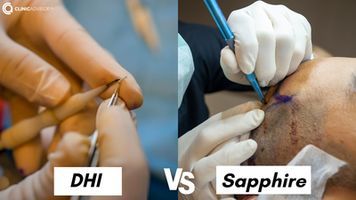Donor area extraction ( also called hair grafts extraction) is one of the core stages of any hair transplant procedure
All hair transplant procedures (except in DHI) go through 3 main stages which include the extraction of the hair grafts, the incisions stage, and the hair grafts implant stage.
They all share a must stage which is the donor area extraction phase. This stage can follow many ways in an FUE hair transplant and follows a single way in a FUT hair transplant.
In this article, we will discuss these ways of harvesting in hair transplants.
Donor Area Harvesting in FUT
First, let's start with the donor area harvesting using the FUT (Strip) technique.
In the FUT hair transplant procedure, the hair grafts are obtained by excising a strip of the skin from the donor site (back of the head) which is genetically resistant to male pattern baldness.
The two edges of the scalp are joined together and the wound is closed with sutures.
The assistants then start dissecting the follicular units and they use microscopes to carefully remove the extra fatty tissues from around the follicular units.
The follicular units are grouped according to the type and how many hair follicles each unit consists of. There are single, double, triple, or four follicular units.
This means that a single follicular unit will have 1 hair graft while a double follicular unit will have 2 hair grafts and so on.
This type of hair transplant was widely used when hair restoration procedures first began to be popular.
However, with the introduction of the FUE procedures, the FUT is not as widely used as it was before.
Although there are surgeons who still use it to date; however, it is not favored by many doctors and patients alike due to the linear scar it leaves on the back of the scalp and the limited number of extracted grafts, maximum of 2500 hair grafts.
Types of FUE Extraction
When using the Follicular Unit Extraction (FUE) technique donor harvesting or extraction of the hair from the donor area is done one by one.
The FUE hair graft extraction (donor harvesting) can be categorized into 4 types:
Manual FUE
The manual FUE refers to extracting the hair follicles from the donor area manually. This is done with the help of a handheld piece with a punch attached to it.
Surgeons rotate the punch with the aid of their fingertips to make a cut around the follicular unit and extract the hair grafts.
Here is a demonstration of how the manual FUE is performed.
This was the method used when the FUE was first introduced to the hair restoration field.
Although many clinics and doctors still use it many have shifted to the new extraction type which is the motorized FUE.
For more details about manual FUE hair transplant, you can read this article.
Motorized FUE
The motorized FUE has made it easier and faster for hair transplant doctors to remove hair grafts.
So, instead of holding the punch and rotating manually with the fingertips, the punches are now powered.
This means that the punches are connected to a powered handheld device that rotates rapidly to separate the hair grafts from the skin.
This advancement enabled faster harvesting and more grafts can be obtained in a single session up to (3000-5000) hair grafts.
On the contrary, the manual FUE only allows the extraction of about 2000-2500 hair grafts since it involves a lot of effort.
Robotic FUE
The Robotic FUE is a computer-programmed 3D imaging system that has the ability to identify and excise the skin around the hair grafts without the involvement of the surgeon.
The surgeon and his team then pick out the excised hair follicles and group them.
The robot uses artificial intelligence and algorithms to program and plan how the hair grafts will be harvested. This means that it is designed to leave spaces between hairs for less scarring.
There are two famous robotic systems such as ARTAS and HARRTS.
Nowadays, modern robots can perform the implantation stage as well. However, there are some controversial opinions regarding their effectiveness.
Very few surgeons use the Robotic FUE as it is a very expensive system for both the clinic and the patient. It also takes a longer period to extract a very limited number of hair grafts.
Here is a video by Dr. Bernstein explaining how the Robotic FUE graft extraction is performed.
NeoGraft FUE
The NeoGraft FUE is also another type of FUE hair graft extraction that is not widely used.
The extraction process is basically the same as the normal FUE; however, instead of manually collecting or picking out the grafts with the forceps pneumatic pressure is used to suction the excised hair follicles.
But one of the drawbacks of this method is that the suctioning of the follicles may increase the possibility of damaging them.
Some may promote this type of hair extraction as the automated FUE. But this could be misleading because using the word automated implies that the device does all the work without human involvement, which is not the case here.
What is the best method to extract hair grafts when using the FUE technique?
So, if you wonder what is the best FUE type to harvest the hair grafts the answer would be there is no single method.
Different doctors have different skills. Some have developed their skills in performing manual extraction of grafts. While others work better with motorized extraction devices or the robotic system.
Another factor in selecting the type of FUE extraction method is how much you’re aiming to cover.
If you are aiming for 3000-5000 hair grafts your doctor might recommend using the motorized FUE.
While for small areas fewer grafts are required therefore a manual punch or robotic punch is preferred.
It all depends on your doctor’s skills, your hair type, your hair loss degree and how many grafts you need, and of course your budget.









Share Your Opinion, Please